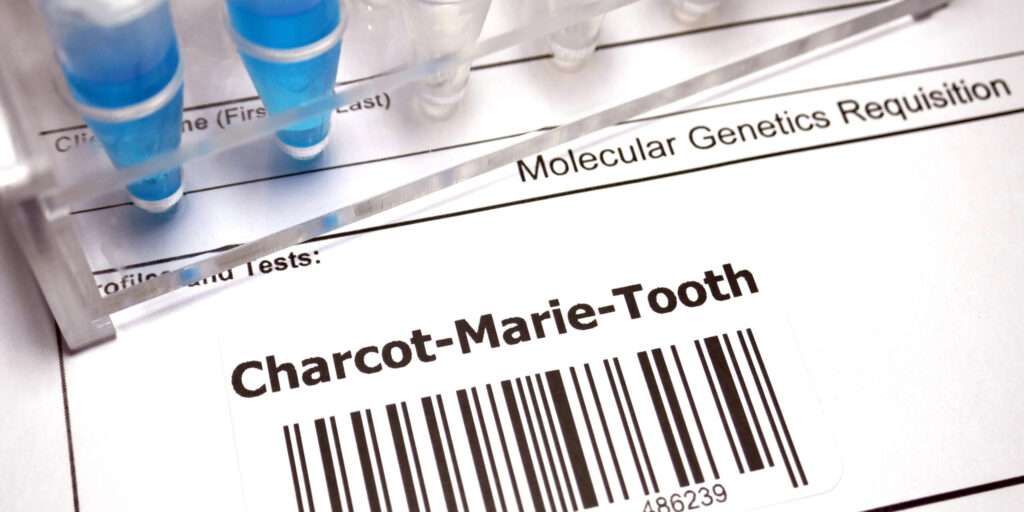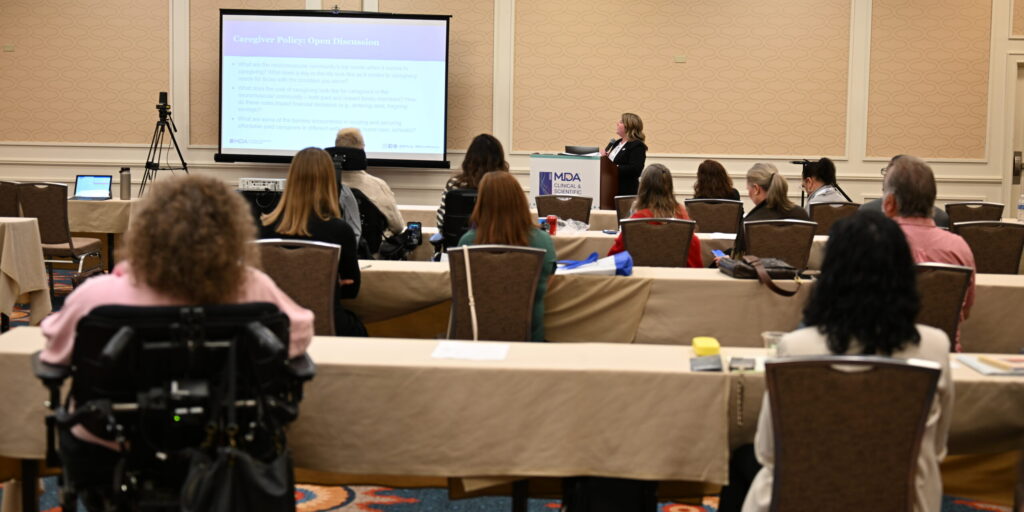
Simply Stated: Updates in Charcot-Marie-Tooth Disease (CMT)
By Sujatha Gurunathan | Thursday, September 26, 2024
5 Second Summary
“Simply Stated” is a Quest column designed to explain some terms and basic facts about neuromuscular diseases.
Find more at Mdaquest.org/tag/simply-stated
Charcot-Marie-Tooth disease (CMT) is a diverse group of inherited disorders that affect movement and sensation in the arms, legs, hands, and feet. People affected by CMT commonly experience lower leg weakness, foot deformities, and reduced sensations, such as the ability to feel heat, cold, and touch. Sometimes fine motor functions of the hands and fingers can be affected. CMT typically progresses slowly and may spread to other parts of the body over time. The disease can also lead to secondary problems like scoliosis (curvature of the spine). The symptoms and severity of CMT vary greatly between different people with the disease.
The National Institute of Neurological Disorders and Stroke (NINDS) describes CMT as one of the most common inherited neurological disorders, affecting an estimated 126,000 individuals in the United States (US) and 2.6 million people worldwide.
To get a birds-eye view of the current understanding of CMT, see Q&A with CMT expert Stephan Zuchner, MD, PhD.
Causes of CMT
CMT is caused by defects (mutations) in more than 100 different genes. In general, the genes associated with CMT encode proteins that contribute to the structure or function of peripheral nerves (those that transmit information between the brain/spinal cord and the rest of the body) and/or myelin (the protective covering that surrounds the nerves). Most cases of CMT are caused by defects in one of four genes: PMP22, MPZ, GJB1, or MFN2. The disease is hereditary, and can be passed down from parents to their children through three common inheritance patterns, autosomal dominant (caused by one defective gene copy), autosomal recessive (caused by two defective gene copies), and X-linked (caused by a defective gene on the X chromosome).
In people with CMT-causing mutations, the affected nerves degenerate over time and lose the ability to communicate with muscles in the body. This can cause weakness and atrophy (thinning) of the muscles in the arms, legs, hands, and feet, leading to CMT symptoms.
CMT subtypes
The genetics of CMT are complex. Defects in different genes can produce similar symptoms. Alternatively, different defects in a single gene can produce different symptoms. The various presentations of CMT are classified into subtypes based on similarities found in clinical features, the type of nerve dysfunction, and inheritance patterns. These subtypes are named CMT types 1 through 4, plus an X-linked type. A letter is added after the name of the subtype to denote association with a particular gene defect (e.g. CMT1A is caused by a PMP22 mutation, CMT1B is caused by a MPZ mutation, etc.).
The different subtypes of CMT present with different features, including age of onset, severity, specific patterns of neuropathy (nerve damage), and clinical symptoms. CMT1 is the most common subtype, affecting more than 50% of people with the disease. Symptoms of CMT1 usually begin in childhood. The X-linked form of CMT is the second most common form, and primarily affects males beginning in late childhood or adolescence.
Diagnosis and Management of CMT
CMT is typically diagnosed using a variety of assessments including a thorough medical and family history, complete neurologic examination, electrodiagnostic testing, and confirmatory genetic testing.
There are no disease-modifying treatments currently available for CMT, but supportive therapies can help improve overall health and quality of life of people with the disease. Multidisciplinary care provided by neurologists, genetic counselors, nurses, physical therapists (PT), occupational therapists (OT), physiatrists, and orthopedic surgeons can be beneficial. Some recommendations may include:
- Strategies and adaptations to help accomplish tasks of daily living
- Special stretches and exercises to maintain arm and leg strength and reduce muscle cramping
- Braces/orthopedic devices and assistive devices such as canes and walkers to help with mobility
- In some cases, corrective surgery to help with foot problems
For more information about the signs and symptoms of CMT, as well an overview of diagnosis, prognosis, and care management concerns, an in-depth review can be found from T. Bird, 2024.
Evolving research and treatment landscape
Both supportive interventions and disease-modifying therapies, including genetic correction strategies, are in the drug development pipeline for CMT. Promising strategies under active investigation for CMT include small molecule therapy, gene therapy, stem cell therapy, and siRNA and antisense oligonucleotide (AON) gene silencing therapies. Dozens of drug development programs are underway, targeting CMT subtypes including CMT1A, CMT2A, CMT4B1, SORD deficiency, CMT1B, CMT2S and CMT4J. Here, we highlight a few recent developments in CMT research:
Therapeutic development for SORD deficiency
In 2020, genetic defects in the sorbitol dehydrogenase gene (SORD) were discovered as the cause of a form of CMT known as SORD deficiency. Two drugs, epalrestat and ranirestat, appear to reverse some effects of SORD mutations in the context of another condition, diabetic neuropathy. Epalrestat is currently marketed in a few countries (not the US) for the treatment of diabetic complications, while ranirestat has been studied in late-stage clinical trials. Both drugs have been shown to be safe and well-tolerated in patients. Re-purposing of these drugs to treat SORD deficiency represents a promising therapeutic strategy for CMT.
Another drug, govorestat (AT-007) (Applied Therapeutics), is also being developed as a therapy for SORD deficiency. Interim 12-month results from the phase 3 INSPIRE trial of govorestat were announced in February 2024. The trial sponsors reported that patients receiving govorestat showed physiologic improvements (i.e., reduction in toxic sorbitol levels) and improvements on measures of disease severity and well-being. Improvements were specifically seen in lower limb function, mobility, fatigue, pain, sensory function, and upper limb function. Though currently investigational, govorestat may become the first therapy approved by the US Food and Drug Administration (FDA) for the treatment of SORD deficiency.
Gene delivery strategies
As the underlying genetic causes of the different forms of CMT become known, subtype-specific genetic correction strategies are becoming a focus of new therapeutic development. One research group is targeting CMT1A using a gene therapy strategy to counter the defective PMP22 gene that causes the disease. The researchers have developed a genetic tool, specifically a viral vector (AAV9) that introduces a small piece of genetic material (miRNA) to stop too much of the toxic PMP22 gene product from being made. This gene therapy was tested in a mouse model of CMT1A and was shown to decrease markers of disease and increase functional outcomes in the animals. This study provided proof of principle for treating CMT1A using a gene therapy approach.
In 2023, MDA and the Charcot Marie Tooth Association (CMTA) co-funded another group working on a gene therapy strategy to treat CMT. The grant was for a 3-year research project entitled: Nanoparticle-based gene delivery to Schwann cells for treating CMT disease, led by Dr. Alexia Kagiava of the Cyprus Institute of Neurology & Genetics in Nicosia, Cyprus. In this project, Dr. Kagiava and her research team are working to improve a gene therapy approach that they previously developed to treat X-linked CMT. X-linked CMT is caused by mutations affecting connexin32 (Cx32), a protein that is involved in signaling between nerves. Dr. Kagiava’s gene therapy works by delivering the gene encoding Cx32 using a viral vector (AAV9) into the space surrounding the spinal cord (intrathecal injection). In a mouse model of CMT, use of this viral vector resulted in widespread and long-lasting expression of the gene encoding Cx32, leading to improvements in disease pathology and functional improvements. Dr. Kagiava is now working to develop a safer and potentially more targeted gene therapy using a specially designed nanoparticle to deliver the gene encoding Cx32.
Clinical trial readiness
Natural history studies
To support treatments that are entering the clinic, researchers are also working to optimize clinical trial design. This includes conducting natural history studies of individual CMT subtypes to gain greater clarity on disease progression and to identify outcome measures for use in future clinical trials. A number of such studies are being led by the Inherited Neuropathies Consortium (INC), a research group funded by the National Institutes of Health (NIH) and advocacy organizations including MDA, and run by researchers at leading universities and neuromuscular centers. The INC is currently recruiting patients to enroll in CMT natural history studies across the US and in several sites in Europe and Australia.
Patient registries
Several advocacy groups have established patient registries to help collect data from patients with CMT, which can be used for research to improve understanding of the disease. CMTA has an extensive patient registry that people with CMT can now sign up for using a convenient mobile application. The Hereditary Neuropathy Foundation (HNF) hosts a global patient registry for people with CMT, and has also launched a digital health study in collaboration with BioSensics to collect patient data remotely. MDA works with these foundations in various ways, including co-funding grants and sponsoring INC along with these other organizations.
Outcome measures
One challenge in drug development for CMT is that the disease is typically slowly progressive. As a result, it is difficult to capture efficacy of new interventions within the time window of a clinical trial, contributing towards a number of failed clinical trials thus far. There is an urgent need to identify responsive outcome measures that can be used to more quickly measure efficacy of new therapeutics in clinical trials.
One outcome that has recently been identified as a responsive measure in many common subtypes of CMT is the intramuscular fat fraction (FF). The feasibility of FF as an outcome measure for CMT1A and other subtypes of the disease was recently reported in two studies from Doherty, et al., both of which were funded by MDA.
Biomarkers
Another area of evolving research in CMT is the identification of sensitive biomarkers of disease. Specifically, researchers are attempting to identify proteins in the blood of people with CMT that can be used to quickly and accurately diagnose the disease. Several biomarkers have been proposed as sensitive diagnostic biomarkers in animal models of various CMT subtypes and in patients with CMT.
Training of CMT clinical evaluators
Given the variability of CMT presentation and the lack of standardized measures of disease progression, evaluating outcomes in clinical trials for CMT interventions has been challenging. Dr. Joshua Burns of St. Jude Children’s Research Hospital is working to establish a global certification standard for evaluating CMT disease, which includes training of reliable clinical evaluators and implementing use of standardized outcome measures, to improve the quality and consistency of CMT trials. In August 2024, MDA awarded Dr. Burns a $300,000 Research Infrastructure Grant to further this work.
MDA commitment to CMT research
By the end of 2024, MDA will have invested more than $44M in CMT research. Strategic investments from MDA and other advocacy organizations, combined with traditional funding sources such as the National Institute of Health (NIH), are helping to move the field of CMT forward.
MDA’s Resource Center provides support, guidance, and resources for patients and families, including information about CMT, open clinical trials, and other services. Contact the MDA Resource Center at 1-833-ASK-MDA1 or ResourceCenter@mdausa.org.
Next Steps and Useful Resources
- For more information about Charcot-Marie-Tooth disease (CMT), a full list of symptoms and causes can be found here.
- To get a birds-eye view of the current understanding of CMT, see Q&A with CMT expert Stephan Zuchner, MD, PhD.
- For more information about the signs and symptoms of CMT, as well an overview of diagnosis, prognosis, and care management concerns, an in-depth review can be found from T. Bird, 2024.
- CMTA has an extensive patient registry that people with CMT can now sign up for using a convenient mobile application.
- MDA’s Resource Center provides support, guidance, and resources for patients and families, including information about exon skipping therapies, open clinical trials, and other services. Contact the MDA Resource Center at 1-833-ASK-MDA1 or ResourceCenter@mdausa.org.
- Stay up-to-date on Quest content! Subscribe to Quest Magazine and Newsletter.
Disclaimer: No content on this site should ever be used as a substitute for direct medical advice from your doctor or other qualified clinician.




